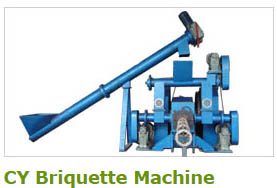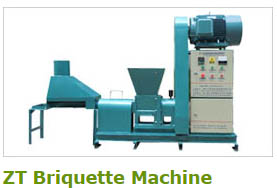Characters of Briquette Charcoal by Charcoal Briquette Machine
Characters of Briquette Charcoal
Briquette charcoal made by the charcoal briquette machine is widely used in industrial and agricultural fields as well as people’s daily life recently. In fact, briquette charcoal can be made from biomass waste like sawdust or wood shavings. Therefore, many people who have large quantity of wood waste want to invest in charcoal briquette machines. But most of them are not clear about the characters of briquette charcoal.
It can be acquired from wood material combustion and decomposition in the anoxic state. Generally, different burning temperatures can produce charcoal with different colors. Charcoal made at around 250 degrees centigrade appears brownish and it is hard to be snapped off while 300-450 degrees will result in black appearance. However, the black surface will become even glossy in the temperature of above 700 degrees and clangorous sound can be heard when it is knocked. Its mechanical strength is reinforced higher in the longitude but weaker in the radial direction even reaching the lowest chordwise. Within the similar close fire temperature, its strength will expand along with the burning time.

With the general value of 0.8-1.2g/cm3, its density will vary because of changes in kind, quality, close fire temperature and the combustion temperature. But the higher the specific gravity of wood material, the heavier the charcoal will be charred. Charcoal does possess a relative large specific surface and the stronger ability of absorption. The total surface of just one gram charcoal can possess 500 square meters.
Get to know Kingman Charcoal Briquette Machine now
Historically, production of wood charcoal in location where there is an abundance of wood dates back to a very ancient period. Charcoal has been made by various methods. Charcoal is a formless mass of carbon and can be made from most carbonaceous materials. It is one of the oldest of manmade fuel and has been prepared under the ground for a thousand years.
Wood charcoal production dates back to ancient human prehistory where stacks of wood logs on their ends were formed into a pyramidal pile. Much like the old process, the modern commercial charcoal process is to heat wood with little or no air present which takes special but simple equipment. In the United States, wood is the primary material used for charcoal and is generally procured in the form of residue from sawmills—slabs and endings. While charcoal can be made from any number of natural materials, hardwoods such as hickory, oak, maple, and fruit-woods are favored. They have unique aromas and tend to produce a better grade of charcoal. Better grades of charcoal come from raw materials with low sulfur content.
The uses of charcoal may surprise you. Besides being the fuel that cooks steaks, hotdogs, and hamburgers on a Sunday picnic, charcoal is used in many other processes. It is used in certain metallurgical "purifying" treatments and as a filter to remove organic compounds such as chlorine, gasoline, pesticides, and other toxic chemicals from water and air.
Thermal value of charcoal remains about 6500-8000Kcal/kg, being higher along with the carbonizing temperature rise and increased carbon content.
Ash content of charcoal is various due to the difference in carbonizing temperature, material breed, bark content and carbonizing way. The higher the carbonizing temperature goes, the higher the ash content will be. Ash content of carbonized broad-leaves tree material is higher than that of coniferous woods. Bark is higher than timber.
Electrical conductivity: upon the close fire temperature exceeding 700 degrees, atomic structure of charcoal will be changed with hexagon ring plane layers of graphite-like atom produced. Therefore it will become more electric. But it will not happen when the temperature is lower than 600 degrees.
Combustibility: complete combustion of charcoal in the open air will produce much more heat and carbon dioxide, otherwise, with more carbon monoxide coming out.
Reducibility: it can be used as reducing agent. For example, powdered carbon can be heated with copper oxide to acquire red-color copper.
Charcoal briquette machine is the most important part in charcoal briquettes production. So to choose a good charcoal briquette machine is the first thing that you need to consider. As one of the earliest and largest biomass briquette press manufacturer, Kingman cordially expects briquette machine and carbonizing furnace prouced by our company become the best helping hand for your green business and bring more added value for your career.
--------------------------------------------------------------------------------------------------------------
Do you have sawdust and saw shavings? Do you want to turn them into briquette fuel or briquette charcoal? Here you can get to know how to use charcoal briquette machine or a briquette plant to make briquettes and charcoal.




